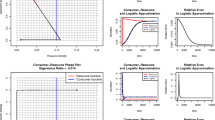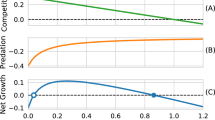Abstract
Analysis of the biophysical conditions for a correct application of the Volterra Competition Equations with resource-independent coefficients reveals the following:
The traditional, mathematical formalism with the two equations representing two straight lines at the condition of zero growth applies.
As a directly resource-limited situation does not permit for stable equilibrium (One-line or K-system, Walker [18]; Ceiling model, Pollard [11]), the combined equilibrium density represented by the intersect of the two lines (Two-line system or S-system; Equilibrium model; lit. ref. see above) is by necessity smaller than the carrying capacity of shared resources would permit. The physical determinant is density in space as a result of behavioural/physiological interaction between organisms. The traditional inequality conditions then mean that coexistence of species sharing the same space is possible provided density-dependent reduction of growth relative to the intrinsic growth rate is more effective within species than between species. The distance of the intersect from the line linking the specific population densities of single species on the axes is a measure for the overlap in the use of space by the two species; thus, overlap of the spatial niche results in stability.
This biophysical system allows for coexistence of species in identical space/resource niches.
Food-jealous behaviour is a direct function of density in space; it is only indirectly and inconsistently influenced by resource availability.
Similar content being viewed by others
References
Gause, G.F., and Witt, A.A. (1935). Behaviour of mixed populations and the problem of natural selection.- The American Naturalist 69: 596–609.
Harris, D.O. (1971). A model system for the study of algae growth inhibitors.- Arch Protistenk 113: 230–234.
Henderson, P.A. (1978). Population studies and behaviour of Cypridopsis vidua (O. Fr. Müller), (Crustacea, Ostracoda).- London: Ph D thesis, Dpt of Zoology, Imperial College, 140 p.
Kidder, G.W. (1941). Growth studies on ciliates V. The acceleration and inhibition of ciliate growth in biologically conditioned medium. Physiol Zool 14: 209–226.
Krebs, C.J. (1972). Ecology.- New York and London: Harper international edition, 694 p.
Lloyd, J.A. (1975). Social structure and reproduction in two freely growing populations of house mice (Mus musculus L.).- Animal Behaviour 23: 413–424.
Lotka, A.J. (1932). The growth of mixed populations: two species competing for a common food supply.- J Wash Acad Sci 22: 461–469.
McArthur, R.M. (1972). Geographical ecology.- New York: Harper and Row, 296 p.
Orians, G.H., and Willson, M.F. (1964). Interspecific territories in birds.- Ecology 17: 736–745.
Pianka, E.R. (1976). Competition and niche theory.- In R.M. May, ed., Theoretical ecology, 114–141. Oxford and London: Blackwell Scientific Publications, 317 p.
Pollard, E. (1981). Resource limited and equilibrium models of populations.- Oecologia (Berl) 49(3): 377–378.
Volterra, V. (1926). Variazioni e flutuazioni del numero d'individui in specie animali conviventi.- Atti R Acad Naz del Lincei 1: 1–85.
Volterra, V. (1931). Ricerche matematiche sulle associazioni biologiche.- Estratto dal Giornale dell' Istituto Italiano degli Attuari 2/9, 65 p.
Walker, I. (1967). Effect of population density on the viability and fecundity in Nasonia vitripennis Walker (Hymenoptera, Pteromalidae).- Ecology 48: 294–301.
Walker, I. (1972). Biological memory.- Acta Biotheoretica 21: 203–235.
Walker, I. (1975). Density-dependent control of fission rates in the marine ciliate Keronopsis rubra Ehrenberg (Hypotricha, Oxytrichidae). The J anim Ecol 44: 707–717.
Walker, I. (1979). Mechanisms of density-dependent population regulation in a marine copepod (Amphiascoides spec., Harpacticoida) from the Dar-es-Salaam coast.- Mar Ecol Progr Series 1: 209–221.
Walker, I. (1983). The physical dimensions and biological meaning of the coefficients in the Volterra competition equations and their consequences for the possibility of coexistence.- Acta Biotheoretica 32: 93–122.
Wangersky, P.J. (1978). Lotka-Volterra population models.- Ann Rev Ecol Syst 9: 189–218.
Wilson, E.O. (1975). Sociobiology.- Cambridge (MA) and London: The Belknap Press of Harvard Univ Press, 697 p.
Author information
Authors and Affiliations
Rights and permissions
About this article
Cite this article
Walker, I. The volterra competition equations with resource - Independent growth coefficients and discussion on their biological and biophysical implications. Acta Biotheor 33, 253–270 (1984). https://doi.org/10.1007/BF00048431
Received:
Issue Date:
DOI: https://doi.org/10.1007/BF00048431




